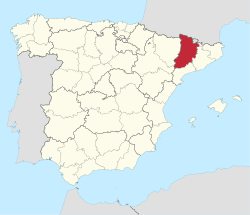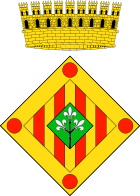Province of Lleida
| Province of Lleida Província de Lleida (Catalan) Provincia de Lhèida (Occitan) | |||
|---|---|---|---|
| Province | |||
| |||
 Map of Spain with Province of Lleida highlighted | |||
| Country | Spain | ||
| Autonomous community | Catalonia | ||
| Capital | Lleida | ||
| Government | |||
| • President | Joan Reñé i Huguet | ||
| Area | |||
| • Total | 12,150 km2 (4,690 sq mi) | ||
| Area rank | Ranked 18th | ||
| 2.41% of Spain | |||
| Population (2013) | |||
| • Total | 440,915[1] | ||
| • Rank | Ranked 33rd | ||
| Official language(s) | Catalan, Spanish and Aranese (Occitan) | ||
| Parliament | Cortes Generales | ||
| Website |
www | ||

The Province of Lleida (Catalan pronunciation: [ˈʎɛjðə], locally: [ˈʎejðɛ]; Spanish: Lérida; Occitan: Lhèida) is one of the four provinces of Catalonia. It lies in north-eastern Spain, in the western part of the autonomous community of Catalonia, and is bordered by the provinces of Girona, Barcelona, Tarragona, Zaragoza and Huesca and the countries of France and Andorra. It is often popularly referred to as Ponent (i.e. the West). It is the only province within Catalonia that is landlocked.
Of the population of 414,015 (2007), about 30% live in the capital, Lleida. Some other towns in Lleida province are La Seu d'Urgell (see of the archbishop, who is also the co-prince to Andorra), Mollerussa, Cervera, Tàrrega, Balaguer. There are 231 municipalities in Lleida. (See List of municipalities in Lleida).
Located in the Pyrenees, the Aran Valley is a special comarca with greater autonomy and with Aranese, a variety of Occitan, as its official language.
The Aigüestortes i Estany de Sant Maurici National Park is located in this province.
The province enjoys a thriving fruit-growing industry, including pears and peaches.
According to the 2006 Statute of Autonomy of Catalonia, the provinces of Catalonia are due to be superseded by territorial units (unitats territorials) or vegeries based on a more historical political division, and the Province of Lleida would become two territorial units: Ponent or Terres de Lleida Vegueria (the entire southern area) and Alt Pirineu i Aran Vegueria (the entire northern part plus the comarca of Cerdanya, part of which is currently in the Province of Girona), the county of Solsona going to the Comarques Centrals (Central Counties) Vegueria. The plan is on hold for the time being (2015).
Language
The Province of Lleida has a characteristic Catalan dialect popularly known as lleidatà, with lo, los used as the masculine definite article instead of el, els and also its pronunciation in a large number of words. One example of the pronunciation is the a at the end of the word that is pronounced like an e. The local dialect, properly known as North-Western Catalan is part of the Western Catalan block, and as such, shares some features with Valencian (whose dialects are also part of that group).
Tourism
Lleida is located in the western part of Catalonia and in the north-west of the Iberian Peninsula, between Barcelona and Madrid, and not far from Saragossa, and borders on France and Andorra to the north. This is a popular destination for many of those who love mountain activities and who are fans of skiing, culture and adventure sports, but it is also a destination that offers a wide variety of other tourism options which are ideal for holidays with friends and family.
Nature
In terms of its natural environment, Lleida offers a wide variety of landscapes. In the high mountain area of the Pyrenees, visitors will find nature in its purest form. Special mention should be made of: the Aigüestortes i Estany de Sant Maurici National Park, which is the only National Park in Catalonia; and the Alt Pirineu (High Pyrenees) and Cadí-Moixeró natural parks. In the Pre-Pyrenees, amongst other places of interest, visitors will find the Collegats-Terradets Territorial Park, the Boumort Natural Hunting Reserve and the Congost de Mont-rebei gorge. In contrast, the Lleida Plain offers more peaceful landscapes. In some cases, these are rather sober, while in others, visitors will find fertile land with century-old olive trees, fruit trees, meadows and crop fields. In this area, it is particularly relevant to highlight such spectacular settings as the Estany d'Ivars i Vila-sana pool and the Aiguabarreig (confluence) of the rivers Segre, Cinca and Ebro.
Sports
The comarques (local districts) of Lleida are also market leaders within Spain in the provision of adventure sports, with more than 170 companies organising around fifty different activities on land and water and in the air. This area is also Spain's leading ski destination. Lleida has 11 different ski resorts which are marketed under the brand "Neu de Lleida" (Lleida Snow) and offer over 450 km of ski slopes. Their 81 ski lifts have the capacity to carry 115,000 skiers per hour, while the area immediately surrounding these winter sports complexes can also accommodate more than 30,000 visitors.
Culture
Lleida's rich monumental heritage – which is crowned by elements of its Romanesque heritage, which has its maximum expression in the churches of the Vall de Boi, which have been declared part of a UNESCO World Heritage Site – is further complemented by a wide range of festivities and sporting and cultural events. It is also important to pick out some of the many new initiatives that have helped to extend the seasonal offer of Lleida's tourism sector. These include: the Centre d'Observació de l'Univers (Centre for Observing the Universe), or PAM, of Montsec, which is an ambitious project that combines research, education and diffusion within the field of cultural and scientific tourism; the establishment of the Tren dels Llacs (Lakes Train), a touristic railway that connects the provincial capital to the Pre-Pyrenees; the creation of new exhibition spaces (including the Museum of Lleida, the Paper Dresses Museum of Mollerussa and the Skiing Museum of the Val d'Aran); the organisation of routes to help discover the natural, cultural and monumental treasures of Lleida (with the Castles of Sió Route, the Pyrenean Counties and Nostalgic Pallars Route, the Wine Route of Les Garrigues, and the Literary Routes of Pallars, etc.); and also projects to promote excellence in the field of tourism, such as the Network of Villages with Charm.
The city of Lleida
Lleida, the capital of the province, is also remarkable for its historical-architectural legacy, which includes sights as splendid as the Seu Vella (old cathedral), a veritable jewel of Romanesque and Gothic architecture, and the Knights Templar Castle of Gardeny, for instance. These buildings coexist with equally interesting modern constructions such as La Llotja, a congress and conference centre. The diocese and county museum, with its collection of Roman, Islamic, Romanesque, Gothic, Renaissance and Baroque artefacts and paintings is also worth a visit, as are the Jaume Morera Museum of Modern Art and the "Roda Roda" Automobile Museum.
Visit Lleida Brand
In recent years, improved communications have also helped to strengthen Lleida's position as one of the Spain's leading tourist destinations. Within this context, it is particularly important to highlight infrastructure that has already been consolidated, such as the High Speed Train service that connects Lleida to Barcelona, Madrid and the rest of Spain. It is also hoped that the recently inaugurated Lleida-Alguaire airport will give a further boost to the local tourist sector by positioning Lleida within Europe's regional airport network and increasing its connectivity with different parts of the continent. The Patronat de Turisme (Tourist Board) of the Diputació de Lleida created the "Ara Lleida" tourism brand back in 1990 with the aim of promoting the whole of this territory.
Notes and references
- ↑ Population Figures referring to Municipal Register 1 January 2013 - Instituto Nacional de Estadística. (National Statistics Institute)
See also
- Llista de monuments de Lleida
External links
| Wikimedia Commons has media related to Province of Lleida. |
Coordinates: 42°00′N 1°10′E / 42.000°N 1.167°E


